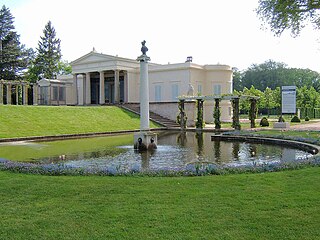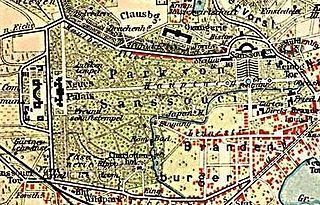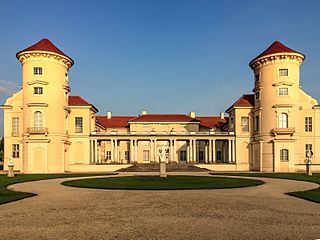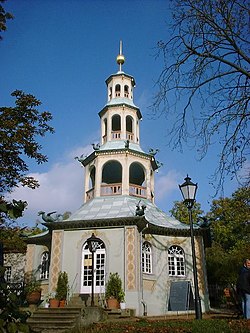
Friedrich Ludwig Persius was a Prussian architect and a student of Karl Friedrich Schinkel.

The Roman Baths, situated northeast of the Charlottenhof Palace in the Sanssouci Park in Potsdam, reflect the Italiensehnsucht of its creator Frederick William IV of Prussia. Various classical Roman and antique Italian styles were melded into an architectural ensemble, created between 1829 and 1840.

The Orangery Palace is a palace located in the Sanssouci Park of Potsdam, Germany. It is also known as the New Orangery on the Klausberg, or just the Orangery. It was built on behest of the "Romantic on the Throne", King Friedrich Wilhelm IV from 1851 to 1864.

The Temple of Friendship is a small, round building in Sanssouci Park, Potsdam, in Germany. It was built by King Frederick II of Prussia in memory of his sister, Princess Wilhelmine of Prussia, who died in 1758. The building, in the form of a classical temple, was built south of the park's main boulevard between 1768 by architect Carl von Gontard. It complements the Temple of Antiquities, which lies due north of the boulevard on an axis with the Temple of Friendship.

The New Chambers is part of the ensemble of Sanssouci palace in Sanssouci Park, Potsdam, Germany. They were constructed for King Frederick the Great of Prussia from 1771 to 1775.

Charlottenhof Palace or Charlottenhof Manor is a former royal palace located southwest of Sanssouci Palace in Sanssouci Park at Potsdam, Germany. It is best known as the summer residence of Crown Prince Frederick William. Today it is maintained by the Prussian Palaces and Gardens Foundation Berlin-Brandenburg.

The Picture Gallery in the Sanssouci Park of Potsdam was built in 1755–64 during the reign of Frederick II of Prussia under the supervision of Johann Gottfried Büring. The Picture Gallery is situated east of the palace and is the oldest extant museum built for a ruler in Germany.

The Chinese House is a garden pavilion in Sanssouci Park in Potsdam, Germany. Frederick the Great had it built, about seven hundred metres southwest of the Sanssouci Summer Palace, to adorn his flower and vegetable garden. The garden architect was Johann Gottfried Büring, who between 1755 and 1764 designed the pavilion in the then-popular style of Chinoiserie, a mixture of ornamental rococo elements and parts of Chinese architecture.

The New Palace is a palace situated on the western side of the Sanssouci park in Potsdam, Germany. The building was begun in 1763, after the end of the Seven Years' War, under King Friedrich II and was completed in 1769. It is considered to be the last great Prussian Baroque palace.

Sanssouci Park is a large park surrounding Sanssouci Palace in Potsdam, Germany, built under Frederick the Great in the mid-18th centurys. Following the terracing of the vineyard and the completion of the palace, the surroundings were included in the structure. A Baroque flower garden with lawns, flower beds, hedges and trees was created. In the hedge quarter 3,000 fruit trees were planted. The greenhouses of the numerous nurseries contained oranges, melons, peaches and bananas. The goddesses Flora and Pomona, who decorate the entrance obelisk at the eastern park exit, were placed there to highlight the connection of a flower, fruit and vegetable garden. Along with the Sanssouci Palace and other nearby palaces and parks, Sanssouci Park was inscribed on the UNESCO World Heritage List in 1990 for its unique architectural unity and testimony to 18th and 19th century landscaping in Europe.

Sanssouci is a historical building in Potsdam, near Berlin. Built by Prussian King Frederick the Great as his summer palace, it is often counted among the German rivals of Versailles. While Sanssouci is in the more intimate Rococo style and is far smaller than its French Baroque counterpart, it, too, is notable for the numerous temples and follies in the surrounding park. The palace was designed and built by Georg Wenzeslaus von Knobelsdorff between 1745 and 1747 to meet Frederick's need for a private residence where he could escape the pomp and ceremony of the royal court. The palace's name is a French phrase meaning "without worries" or "carefree", emphasising that the palace was meant as a place of relaxation rather than a seat of power.

Palaces and Parks of Potsdam and Berlin are a group of palace complexes and extended landscaped gardens located in the Havelland region around Potsdam and the German capital of Berlin. The term was used upon the designation of the cultural ensemble as a World Heritage Site by UNESCO in 1990. It was recognized for the historic unity of its landscape—a unique example of landscape design against the background of monarchic ideas of the Prussian state and common efforts of emancipation.

The Marmorpalais is a former royal residence in Potsdam, near Berlin in Germany, built on the grounds of the extensive Neuer Garten on the shores of the Heiliger See. The palace was commissioned by King Frederick William II of Prussia and designed in the early Neoclassical style by the architects Carl von Gontard and Carl Gotthard Langhans. Despite the name, brick is the main material. The palace remained in use by the Hohenzollern family until the early 20th century. It served as a military museum under communist rule, but has since been restored and is once again open to the public.

The New Garden in Potsdam is a park of 102.5 hectares located southwest of Berlin, Germany, in northern Potsdam and bordering on the lakes Heiliger See and Jungfernsee. Starting in 1787, Frederick William II of Prussia (1744-1797) arranged to have a new garden laid out on this site, and the design and landscaping was carried out by Johann August Eyserbeck, who had previously worked on the Dessau-Wörlitz Garden Realm.

Pillnitz Palace is a restored Baroque schloss at the eastern end of the city of Dresden in the German state of Saxony. It is located on the right bank of the River Elbe in the former village of Pillnitz. It was the summer residence of many electors and kings of Saxony; it is also known for the Declaration of Pillnitz in 1791.

The Historic Mill of Sanssouci is a mill in Potsdam, Germany. Thanks to the legend of The Miller of Sanssouci, the Mill became famous, particularly due to its association with Frederick the Great and his summer palace of Sanssouci.
The Prussian Palaces and Gardens Foundation Berlin-Brandenburg was founded by a treaty of 23 August 1994 between the German federal states of Berlin and Brandenburg as a public foundation following German reunification. The treaty came into force on 1 January 1995. The foundation is separate from the considerably larger Prussian Cultural Heritage Foundation.

Rheinsberg Palace lies in the municipality of Rheinsberg, about 100 kilometres (62 mi) northwest of Berlin in the German district of Ostprignitz-Ruppin.

The Great Pagoda at Kew Gardens in southwest London was built in 1761 by Sir William Chambers as a present for Princess Augusta, the founder of the gardens. Constructed of grey brick, the pagoda comprises 10 storeys, totalling 163 ft (50 m) in height, with 253 steps to the viewing gallery. Closed for repairs in 2006, the pagoda was reopened in 2018 following a major programme of restoration. It is a Grade I listed building.



















